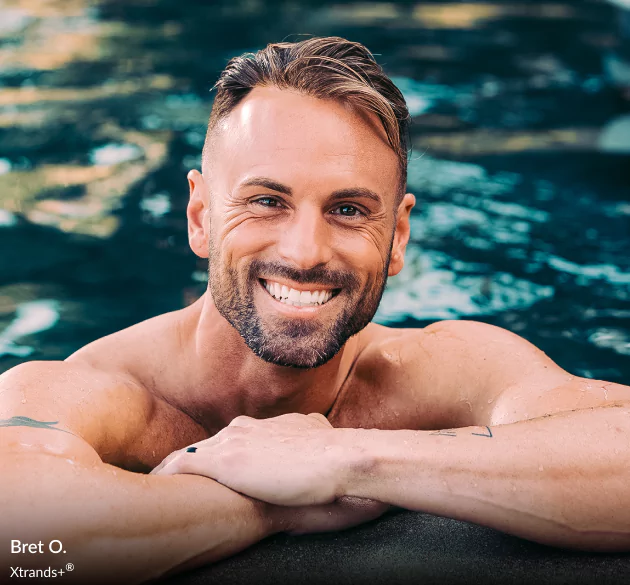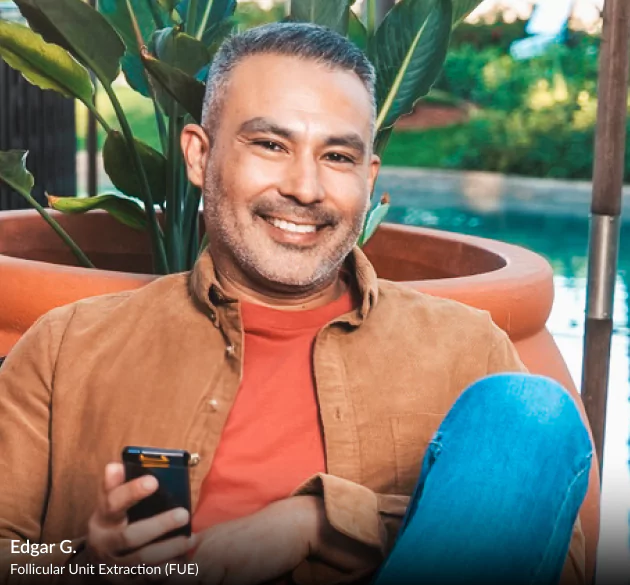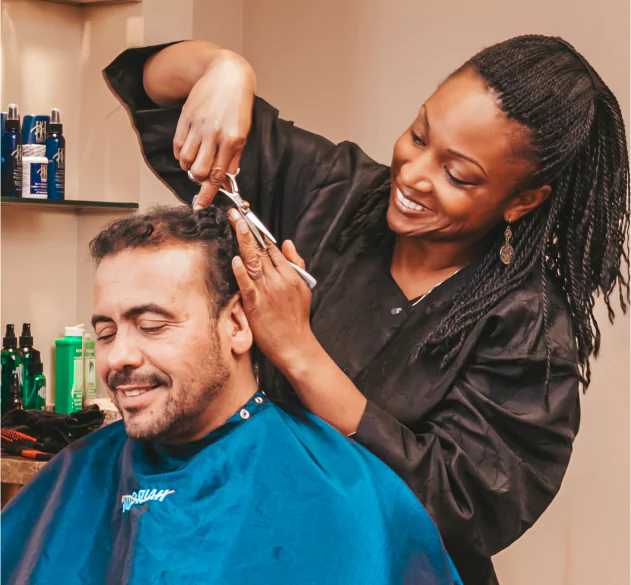Prevention & Regrowth | Laser Hair Therapy
Regrow Your Hair at Home With Laser Therapy for Hair Loss
For many people, hair loss isn’t just hair loss. Seeing your formerly lush locks slip through your hands — sometimes literally — can lead to feelings of sadness, anxiety, and low self-esteem. It can also trigger anger, embarrassment, shame, or social anxiety.
You may be here because you’re searching for treatments for hair loss. Perhaps you’ve heard about laser therapy for hair loss and want to know more about this non-surgical, convenient, at-home solution. Either way, rest assured: There’s no need to withdraw from your social life. HairClub is here for you!
What Is Laser Hair Therapy?
Laser hair therapy — also known as low-level light therapy, low-level laser therapy, LLLT, and photobiomodulation — is a treatment that uses low-intensity laser light to stimulate hair follicles and promote hair regrowth. The procedure is non-invasive and painless, and scientific evidence shows that it can help slow hair loss, increase hair thickness, and improve hair quality.
How It Works To Stimulate Hair Follicles
Researchers believe that by using low-intensity light, LLLT stimulates cellular activity in the hair follicles and improves their overall function, leading to thicker, healthier hair. Let’s break down the possible mechanisms through which LLLT accomplishes this.
LLLT is thought to activate the stem cells in the bulge area of hair follicles, a critical region for initiating new hair growth. As hair grows in cycles, energizing these cells may help trigger dormant follicles to re-enter the growth (anagen) phase and encourage new strands to begin forming.
The light energy used in laser therapy appears to dilate blood vessels around the scalp. Improved circulation delivers more oxygen and nutrients to the follicles, which can support healthier growth and help weakened or miniaturized follicles recover function.
LLLT may increase the production of adenosine triphosphate (ATP), which is the energy cells use. With more energy available, follicle cells may function more efficiently, leading to better protein synthesis and structural support for growing hair.
LLLT may help extend the growth phase by keeping follicles active longer than normal. This could cause increased hair length, density, and resilience over time.
Chronic low-level inflammation around the follicles can interfere with hair growth. Laser therapy may have an anti-inflammatory effect by reducing oxidative stress and calming overactive immune responses to create a healthier environment for growth.
Some people with thinning hair experience a change from thick, pigmented “terminal” hairs to fine, colorless “vellus” hairs. Laser therapy for hair growth may help reverse this process by encouraging follicles to return to terminal hair production, which makes the hair look fuller and more pigmented.
As individual follicles regain function and more hairs enter or remain in the growth phase, overall hair density may increase. The strands themselves may also grow thicker in diameter, which also contributes to a more voluminous and healthier appearance.
Non-Invasive, Drug-Free Treatment Option
Laser therapy for hair loss offers a treatment route that doesn’t involve invasive surgery, painful needles, or prescription medications. It’s applied externally, usually through wearable devices or handheld tools, and doesn’t require downtime or recovery.
Because the therapy doesn’t rely on drugs, you avoid the side effects that sometimes come with topical or oral hair loss treatments, such as scalp irritation or hormonal changes. That’s why it’s an appealing option for people who want a gentler approach, especially those with sensitivities or those who prefer to avoid pharmaceutical interventions entirely.


Benefits of Laser Hair Therapy for Hair Loss
For those experiencing hair loss, finding an effective treatment is like getting the holy grail. Here are the top reasons why laser hair therapy could be your ideal solution.
LLLT can lead to an increase in terminal hair density and thickness, which makes your hair appear fuller and more voluminous. Also, by boosting blood flow to the scalp and hair follicles, it can promote stronger and healthier hair that’s less prone to breakage and shedding.
Research has shown that laser light therapy for hair loss can be particularly effective during the early stages of hair loss, when symptoms are mild to moderate. That’s because the hair follicles are still relatively healthy.
Laser therapy for hair loss is generally considered safe for both types of hair loss. Studies have found that LLLT can stimulate hair growth in individuals with either male or female pattern hair loss.
Is Laser Hair Therapy Right for You?
Amidst the stress of hair loss, it can feel like a gamble to try laser therapy hair loss treatment. How can you even know if it would be worth the expense or if it will work at all?
That’s where HairClub comes in. With our quick, simple hair loss quiz, we’ll help you find something that works for you. Take Our Quiz!
Who Benefits Most From This Treatment?
Men or women with telogen effluvium, early-stage, mild-to-moderate androgenic alopecia (male or female pattern baldness), or other non-scarring forms of hair loss are most likely to benefit from LLLT for hair growth.
Laser hair therapy is also often recommended for people who haven’t responded to standard treatments or don’t want to undergo more invasive procedures.
What To Expect From Your Results
After beginning LLLT for hair loss, it typically takes several months for noticeable results to appear. Here’s what you can cautiously expect to happen after you start treatment:
- You might see an initial increase in hair shedding, which is a positive sign that means new hair follicles are being stimulated.
Expect to see less hair loss and maybe even an increase in hair density and thickness.
Full results are usually seen after a year, with the most significant improvements in hair growth and a noticeable improvement in the hairline.
LLLT is not a quick fix, but rather a long-term commitment. Consistent use is essential to maintain your results and prevent further hair loss.
Remember, results can vary depending on individual factors like your stage of hair loss, how well you follow your treatment plan, and the type of LLLT device you use. Not every treatment works for everyone, and some people may not see any improvement, so it’s important to keep your expectations realistic.

At-Home Convenience With In-Center Support
HairClub’s laser therapy for hair loss lets you treat thinning hair from the comfort of home without sacrificing expert guidance. It’s one of several non-surgical options we offer. If you’re exploring different approaches, our full range of solutions includes everything from topical products to hair restoration procedures.
Use It at Home, Get Support From HairClub Experts
HairClub’s laser therapy systems are designed for at-home use, so staying consistent with your treatment is easy. Whether you select a cap, band, helmet, or comb, your device fits right into your routine. Unlike over-the-counter products, you don’t have to figure it out alone. Personalized guidance, regular progress checks, and ongoing support from your Hair Loss Specialist are all part of the HairClub experience.
You can also check in with your Specialist at your local HairClub center to track your results, ask questions, and adjust your plan as needed. It’s a best-of-both-worlds model that combines your convenience with our professional oversight.
Combine With Other Hair Loss Treatments for Better Results
While laser therapy for hair loss works well on its own, many clients see the most improvement when they combine it with other treatments. HairClub offers customized regimens that might include topical solutions, scalp treatments, or hair regrowth supplements, depending on your specific type of hair loss and other factors.
Using laser hair therapy alongside other treatments can help address multiple factors and improve your hair’s appearance and health. With our support, you don’t have to guess which combination makes sense. We tailor your treatment strategy to fit your needs.

Come see a Hair Loss Specialist to find out which of our cutting-edge solutions is right for you.

FDA-Cleared Technology for Safe Use
All of these devices rely on low-level laser diodes or LEDs that operate in the red to near-infrared light spectrum, typically around 650 to 670 nm (nanometers). This is believed to be the optimal range for follicle stimulation.
Here are the main types of devices:
- Laser combs: These handheld devices contain rows of low-level lasers and/or LEDs that emit light as you brush them through your hair. They’re designed for convenience and targeted application, although they require manual use several times a week.
- Laser helmets and caps: These wearable devices cover the entire scalp and deliver uniform laser exposure across the treatment area. They often contain dozens to hundreds of diodes. They’re more hands-off than combs, usually used for 15 to 30 minutes weekly.
- Laser bands: A hybrid between a comb and a helmet, these semi-rigid bands contain laser diodes, and the user wears the laser band like a headband. These are often quicker to use than caps or helmets and more consistent than handheld combs.
How To Get Started With Laser Hair Therapy
If you’re ready to get started with laser therapy for hair loss — or if you want more information before taking the plunge — here are your first steps.
01
Schedule Your Free Consultation
Reach out to HairClub to schedule your complimentary consultation. It’s that simple!
02
Increasing Blood Flow and Nutrient Delivery
The light energy used in laser therapy appears to dilate blood vessels around the scalp. Improved circulation delivers more oxygen and nutrients to the follicles, which can support healthier growth and help weakened or miniaturized follicles recover function.
03
Personalized Hair Health Plan
At your consultation, we’ll conduct your comprehensive Hair Health Analysis. Your Hair Loss Specialist will examine your scalp and hair with TrichoView®, a cutting-edge tool that gives us an in-depth, magnified analysis of your scalp and hair.
Then, we’ll give you a customized hair analysis report and discuss treatment options to give you the results you want. Together with your Specialist, you can choose the solution that fits your needs, lifestyle, and budget.
Frequently Asked Questions About Laser Hair Therapy
Yes! Various scientific studies have shown that low-level laser therapy hair treatments can be effective, particularly for male and female pattern hair loss (also known as androgenic alopecia).
No two heads of hair are identical, and everyone has different hair goals. We customize our solutions for each client, so putting a definitive price tag on our services is difficult.
The cost of low-level laser therapy for hair loss also depends on which of our FDA-cleared laser devices you choose. Whether it’s a helmet, cap, band, or laser comb, your Hair Loss Specialist will help you select the device that best fits your needs and hair goals.
It really depends on your specific needs. Take our hair loss quiz and set up a consultation with a Hair Loss Specialist, who will conduct your Hair Health Analysis by examining your scalp and hair. Then, we’ll provide a hair analysis report and help you choose the hair regrowth solution that best suits your circumstances, goals, and budget.
According to the National Institutes of Health (NIH), the most commonly prescribed hair loss treatments for men include topical treatments like minoxidil and prescription medications like finasteride. Women are most commonly prescribed antiandrogen medications like spironolactone
Take the First Step Toward Healthier Hair
If you’re experiencing hair loss, you don’t have to face it alone. HairClub has almost 50 years of experience providing hair loss prevention and regrowth solutions, including laser therapy for hair loss. Our compassionate, professional Hair Loss Specialists will help you choose the right hair loss treatment for you.
